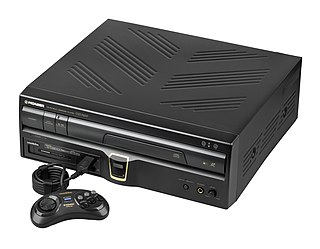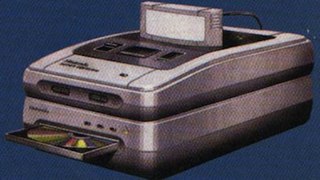 W
WThe Atari Lynx is a hybrid 8-bit and 16-bit handheld game console released by Atari Corporation in September 1989 in North America, and in Europe and Japan in 1990.
 W
WThe Compact Disc-Interactive is a digital optical disc data storage format that was mostly developed and marketed by Dutch company Philips. It was created as an extension of CDDA and CD-ROM and specified in the Green Book, co-developed by Philips and Sony, to combine audio, text and graphics. The two companies initially expected to impact the education/training, point of sale, and home entertainment industries, but CD-i eventually became best known for its video games.
 W
WThe CDTV is a home multimedia entertainment and video game console – convertible into a full-fledged personal computer by the addition of optional peripherals – developed by Commodore International and launched in April 1991.
 W
WThe CP System is an arcade system board developed by Capcom that ran game software stored on removable daughterboards. More than two dozen arcade titles were released for CPS-1, before Capcom shifted game development over to its successor, the CP System II.
 W
WThe Gamate, known as 超級小子 in Taiwan and 超级神童 in China, is a handheld game console manufactured by Bit Corporation in the early 1990s, and released in Australia, some parts of Europe, Asia, Argentina, and the United States.
 W
WThe Game Boy is an 8-bit handheld game console developed and manufactured by Nintendo. The first handheld in the Game Boy family, it was first released in Japan on April 21, 1989. The console was released in North America later the same year, then in Europe in late 1990. It was designed by the same team that developed the Game & Watch series of handheld electronic games and several Nintendo Entertainment System games: Satoru Okada, Gunpei Yokoi, and Nintendo Research & Development 1.
 W
WThe LaserActive is a converged device and fourth-generation home video game console capable of playing LaserDiscs, Compact Discs, console games, and LD-G karaoke discs. It was released by Pioneer Corporation in 1993. In addition to LaserActive games, separately sold add-on modules accept Mega Drive/Genesis and PC Engine/TurboGrafx-16 ROM cartridges and CD-ROMs.
 W
WThe Mega Duck WG-108 is a handheld game console that was developed and manufactured by Hong Kong-based Welback Holdings through its Timlex International division, and released in 1993.
 W
WThe Tandy Memorex Video Information System (VIS) is an interactive, multimedia CD-ROM player produced by the Tandy Corporation starting in 1992. It is similar in function to the Philips CD-i and Commodore CDTV systems. The VIS systems were sold only at Radio Shack, under the Memorex brand, both of which Tandy owned at the time.
 W
WThe Neo Geo , stylised as NEO•GEO and also written as NEOGEO, is a cartridge-based arcade system board and fourth-generation home video game console released on April 26, 1990, by Japanese game company SNK Corporation. It was the first system in SNK's Neo Geo family. The Neo Geo was marketed as 24-bit; its CPU is technically a 16/32-bit 68000-based system with an 8-bit Z80 coprocessor, while its GPU chipset has a 24-bit graphics data bus.
 W
WThe Neo Geo CD is the second home video game console of SNK Corporation's Neo Geo family, released on September 9, 1994, four years after its cartridge-based equivalent. This is the same platform, converted to the cheaper CD format retailing at $49 to $79 per title, compared to the $300 cartridges. The system was originally priced at US$399, or £399 in the UK. The system can also play Audio CDs. All three versions of the system have no region-lock. The Neo Geo CD was launched bundled with a control pad instead of a joystick like the AES version. However, the original AES joystick can be used with all three Neo Geo CD models.
 W
WThe PC Engine SuperGrafx , also known as simply the SuperGrafx, is a fourth-generation home video game console manufactured by NEC Home Electronics and released in Japan in 1989. It is the successor system to the PC Engine, released two years prior. Originally known as the PC Engine 2 during production stages, it was purported as a true 16-bit home console, featuring improved graphics and audio capabilities over its predecessor.
 W
WThe Sega CD, released as the Mega-CD in most regions outside North America and Brazil, is a CD-ROM accessory for the Sega Genesis produced by Sega as part of the fourth generation of video game consoles. It was released on December 12, 1991 in Japan, October 15, 1992 in North America, and April 2, 1993 in Europe. The Sega CD plays CD-based games and adds hardware functionality such as a faster CPU and graphic enhancements such as sprite scaling and rotation. It can also play audio CDs and CD+G discs.
 W
WThe Sega Genesis, known as the Mega Drive outside North America, is a 16-bit fourth-generation home video game console developed and sold by Sega. The Genesis was Sega's third console and the successor to the Master System. Sega released it in 1988 in Japan as the Mega Drive, and in 1989 in North America as the Genesis. In 1990, it was distributed as the Mega Drive by Virgin Mastertronic in Europe, Ozisoft in Australasia, and Tec Toy in Brazil. In South Korea, it was distributed by Samsung as the Super Gam*Boy and later the Super Aladdin Boy. In Russia, it was distributed by Bitman.
 W
WThe Sega Pico, also known as Kids Computer Pico, is an educational video game console by Sega Toys. Marketed as "edutainment", the main focus of the Pico was educational video games for children between 3 and 7 years old. The Pico was released in June 1993 in Japan and November 1994 in North America and Europe, later reaching China. It was succeeded by the Advanced Pico Beena, which was released in Japan in 2005. Though the Pico was sold continuously in Japan through the release of the Beena, in North America and Europe the Pico was less successful and was discontinued in early 1998, later being re-released by Majesco Entertainment. Releases for the Pico were focused on education for children and included titles supported by licensed franchised animated characters, including Sega's own Sonic the Hedgehog series. Overall, Sega claims sales of 3.4 million Pico consoles and 11.2 million game cartridges, and over 350,000 Beena consoles and 800,000 cartridges.
 W
WThe New-Style Super NES is a compact redesign of the original Super Nintendo Entertainment System home video game console released by Nintendo in 1997. In Japan, the system is called the Super Famicom Jr. . Like the redesigned version of the original Nintendo Entertainment System before it, the new-style Super NES was released late during the platform's lifespan.
 W
WThe Super A'can is a home video game console released exclusively in Taiwan in 1995 by Funtech/Dunhuang Technology. It is based around the Motorola 68000 microchip, which is also used in the Sega Genesis and Neo Geo. Twelve games have been confirmed to exist for the system.
 W
WThe Super NES CD-ROM System, known as Super Famicom CD-ROM Adapter in Japan, is an unreleased video game peripheral for the Super Nintendo Entertainment System (SNES). The add-on built upon the functionality of the cartridge-based SNES by adding support for a CD-ROM-based format known as Super Disc.
 W
WThe Super Nintendo Entertainment System (SNES), commonly shortened to Super NES or Super Nintendo, is a 16-bit home video game console developed by Nintendo that was released in 1990 in Japan and South Korea, 1991 in North America, 1992 in Europe and Oceania, and 1993 in South America. In Japan, the system is called the Super Famicom (SFC). In South Korea, it is known as the Super Comboy and was distributed by Hyundai Electronics. The system was released in Brazil on August 30, 1993, by Playtronic. Although each version is essentially the same, several forms of regional lockout prevent cartridges for one version from being used in other versions.
 W
WThe Tandy Memorex Video Information System (VIS) is an interactive, multimedia CD-ROM player produced by the Tandy Corporation starting in 1992. It is similar in function to the Philips CD-i and Commodore CDTV systems. The VIS systems were sold only at Radio Shack, under the Memorex brand, both of which Tandy owned at the time.
 W
WThe Terebikko is an interactive VHS console game system released in Japan by Bandai in 1988. Titles released included a wide variety of known franchises, such as Super Mario World, Dragon Ball Z, and many more. The system was also released in the U.S. as the See 'n Say Video Phone by Mattel in 1989.
 W
WThe TurboDuo is a fourth-generation video game console developed by NEC Home Electronics and Hudson Soft for the North American market. The TurboDuo was test-marketed in Los Angeles in October 1992, before a nationwide rollout in May 1993. It is the North American version of the Japanese PC Engine Duo game console which was released in September 1991.
 W
WThe TurboGrafx-16, known as the PC Engine outside North America, is a fourth-generation home video game console designed by Hudson Soft and sold by NEC Home Electronics. It was the first console marketed in the fourth generation. It was released in Japan in 1987 and in North America in 1989. The Japanese model was unofficially imported and distributed in France and the UK in 1989; in 1990, some other European countries received a PAL version based on the American model known simply as the TurboGrafx. In Japan, the system was launched as a competitor to the Famicom, but the delayed United States release meant that it ended up competing with the Sega Genesis and later the Super NES.
 W
WThe Watara Supervision, also known as the QuickShot Supervision in the UK, is a monochrome handheld game console, originating from Asia, and introduced in 1992 as a cut-price competitor for Nintendo's Game Boy. It came packaged with a game called Crystball, which is similar to Breakout. One unique feature of the Supervision was that it could be linked up to a television via a link cable. Games played in this way would display in four colors, much like Nintendo's Super Game Boy add-on for the SNES. A full color TV link was also in the works, but because of the Supervision's failure to make a major impression among gamers it was cancelled, along with the games which were in development for it.